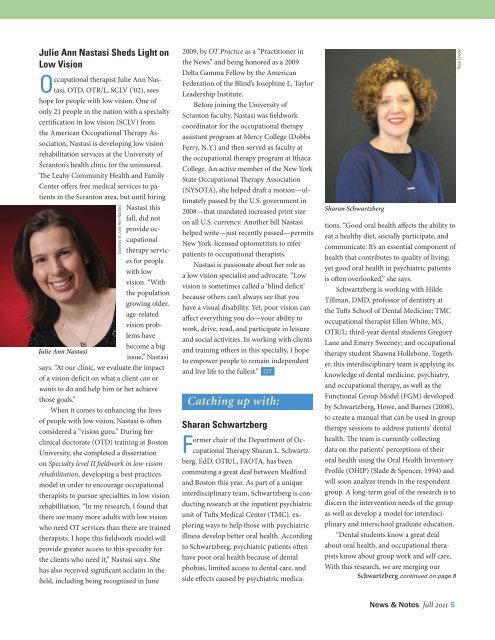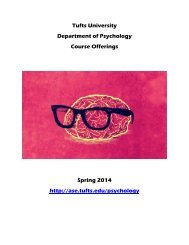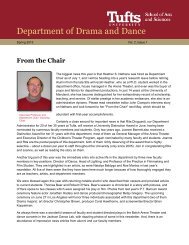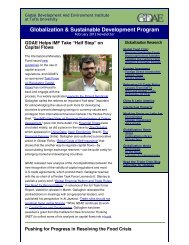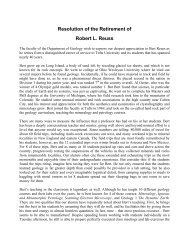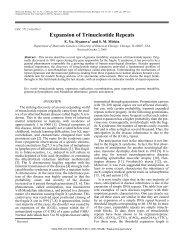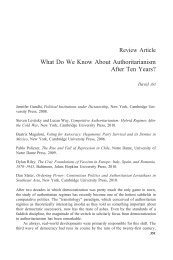Fall 2011 - Tufts University
Fall 2011 - Tufts University
Fall 2011 - Tufts University
You also want an ePaper? Increase the reach of your titles
YUMPU automatically turns print PDFs into web optimized ePapers that Google loves.
Julie Ann Nastasi Sheds Light on<br />
Low Vision<br />
Occupational therapist Julie Ann Nastasi,<br />
OTD, OTR/L, SCLV (’02), sees<br />
hope for people with low vision. One of<br />
only 21 people in the nation with a specialty<br />
certification in low vision (SCLV) from<br />
the American Occupational Therapy Association,<br />
Nastasi is developing low vision<br />
rehabilitation services at the <strong>University</strong> of<br />
Scranton’s health clinic for the uninsured.<br />
The Leahy Community Health and Family<br />
Center offers free medical services to patients<br />
in the Scranton area, but until hiring<br />
Nastasi this<br />
fall, did not<br />
provide occupational<br />
therapy services<br />
for people<br />
with low<br />
vision. “With<br />
the population<br />
growing older,<br />
age-related<br />
vision problems<br />
have<br />
become a big<br />
Julie Ann Nastasi<br />
issue,” Nastasi<br />
says. “At our clinic, we evaluate the impact<br />
of a vision deficit on what a client can or<br />
wants to do and help him or her achieve<br />
those goals.”<br />
When it comes to enhancing the lives<br />
of people with low vision, Nastasi is often<br />
considered a “vision guru.” During her<br />
clinical doctorate (OTD) training at Boston<br />
<strong>University</strong>, she completed a dissertation<br />
on Specialty level II fieldwork in low vision<br />
rehabilitation, developing a best practices<br />
model in order to encourage occupational<br />
therapists to pursue specialties in low vision<br />
rehabilitation. “In my research, I found that<br />
there are many more adults with low vision<br />
who need OT services than there are trained<br />
therapists. I hope this fieldwork model will<br />
provide greater access to this specialty for<br />
the clients who need it,” Nastasi says. She<br />
has also received significant acclaim in the<br />
field, including being recognized in June<br />
Courtesy of Julie Ann Nastasi<br />
2009, by OT Practice as a “Practitioner in<br />
the News” and being honored as a 2009<br />
Delta Gamma Fellow by the American<br />
Federation of the Blind’s Josephine L. Taylor<br />
Leadership Institute.<br />
Before joining the <strong>University</strong> of<br />
Scranton faculty, Nastasi was fieldwork<br />
coordinator for the occupational therapy<br />
assistant program at Mercy College (Dobbs<br />
Ferry, N.Y.) and then served as faculty at<br />
the occupational therapy program at Ithaca<br />
College. An active member of the New York<br />
State Occupational Therapy Association<br />
(NYSOTA), she helped draft a motion—ultimately<br />
passed by the U.S. government in<br />
2008—that mandated increased print size<br />
on all U.S. currency. Another bill Nastasi<br />
helped write—just recently passed—permits<br />
New York-licensed optometrists to refer<br />
patients to occupational therapists.<br />
Nastasi is passionate about her role as<br />
a low vision specialist and advocate. “Low<br />
vision is sometimes called a ‘blind deficit’<br />
because others can’t always see that you<br />
have a visual disability. Yet, poor vision can<br />
affect everything you do—your ability to<br />
work, drive, read, and participate in leisure<br />
and social activities. In working with clients<br />
and training others in this specialty, I hope<br />
to empower people to remain independent<br />
and live life to the fullest.” OT<br />
Catching up with:<br />
Sharan Schwartzberg<br />
Former chair of the Department of Occupational<br />
Therapy Sharan L. Schwartzberg,<br />
EdD, OTR/L, FAOTA, has been<br />
commuting a great deal between Medford<br />
and Boston this year. As part of a unique<br />
interdisciplinary team, Schwartzberg is conducting<br />
research at the inpatient psychiatric<br />
unit of <strong>Tufts</strong> Medical Center (TMC), exploring<br />
ways to help those with psychiatric<br />
illness develop better oral health. According<br />
to Schwartzberg, psychiatric patients often<br />
have poor oral health because of dental<br />
phobias, limited access to dental care, and<br />
side effects caused by psychiatric medica-<br />
Sharan Schwartzberg<br />
tions. “Good oral health affects the ability to<br />
eat a healthy diet, socially participate, and<br />
communicate. It’s an essential component of<br />
health that contributes to quality of living;<br />
yet good oral health in psychiatric patients<br />
is often overlooked,” she says.<br />
Schwartzberg is working with Hilde<br />
Tillman, DMD, professor of dentistry at<br />
the <strong>Tufts</strong> School of Dental Medicine; TMC<br />
occupational therapist Ellen White, MS,<br />
OTR/L; third-year dental students Gregory<br />
Lane and Emery Sweeney; and occupational<br />
therapy student Shawna Hollebone. Together,<br />
this interdisciplinary team is applying its<br />
knowledge of dental medicine, psychiatry,<br />
and occupational therapy, as well as the<br />
Functional Group Model (FGM) developed<br />
by Schwartzberg, Howe, and Barnes (2008),<br />
to create a manual that can be used in group<br />
therapy sessions to address patients’ dental<br />
health. The team is currently collecting<br />
data on the patients’ perceptions of their<br />
oral health using the Oral Health Inventory<br />
Profile (OHIP) (Slade & Spencer, 1994) and<br />
will soon analyze trends in the respondent<br />
group. A long-term goal of the research is to<br />
discern the intervention needs of the group<br />
as well as develop a model for interdisciplinary<br />
and interschool graduate education.<br />
“Dental students know a great deal<br />
about oral health, and occupational therapists<br />
know about group work and self care.<br />
With this research, we are merging our<br />
Schwartzberg continued on page 8<br />
News & Notes fall <strong>2011</strong> 5<br />
Rose Lincoln


